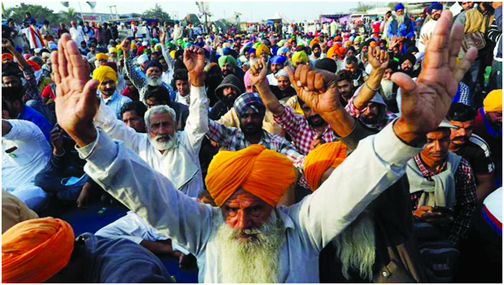
The Covid-19 pandemic severely restricted public activities throughout the year in India as elsewhere in the world. India has been the second-worst affected country by the Covid-19 pandemic and it implemented the strictest lockdown reducing public activities further. Still, India saw big protests, two major communal riots, and a few scams and scandals in 2020.
PROTEST OVER CITIZENSHIP AMENDMENT ACT
The Citizenship Amendment Act came into being in December 2019. Protests against it erupted thereafter with Assam being the focus where protesters linked it with the National Register of Citizens (NRC). The protesters opposed the CAA for allowing citizenship to immigrants, who came in after 1971. By January, the focus of the anti-CAA protests had shifted to Delhi, particularly at Shaheen Bagh. Here, the protesters led the agitation against a provision that made Muslims from Afghanistan, Bangladesh, and Pakistan ineligible to acquire citizenship under the CAA. They were required to go through normal routes of acquiring citizenship of India. The protest made international headlines with the Time magazine featuring an 82-year-old Bilkis Bano – popularly called Dadi – as one of the most influential people. The protest broke off in the view of the spreading Covid-19 pandemic and the consequent lockdown.
Shaheen Bagh protest
The Shaheen Bagh protest was a sit-in peaceful protest, led by women, that began in response to the passage of the Citizenship (Amendment) Act (CAA) in both houses of the Parliament of India on 11 December 2019 and the ensuing police intervention against students at Jamia Millia Islamia who were opposing the Amendment.
Protesters agitated not only against the citizenship issues of the CAA, National Register of Citizens (NRC) and National Population Register (NPR), but also against police brutality, unemployment, poverty and for women’s safety. Mainly consisting of Muslim women, the protesters at Shaheen Bagh, since 14 December 2019, blocked a road in New Delhi using non-violent resistance for 101 days until 24 March 2020. As a precautionary measure Delhi Police barricaded the neighbouring major highways around the area. Following the North East Delhi riots, police barricading and presence in the area increased with over ten companies, 1000 personnel, being assigned to Shaheen Bagh. The protests ended on 24 March 2020 as Delhi Police vacated the site following the COVID-19 pandemic outbreak.
FARMERS’ PROTEST OVER, NEW FARM LAWS
At the other end of the Covid-19-impacted year, Delhi became the theatre of yet another public protest – this time by farmers, mainly from Punjab and Haryana but also from Kerala, over the three farm laws brought out first as Ordinance by the government and later enacted by Parliament.
The three laws are The Farmers’ Produce Trade and Commerce (Promotion and Facilitation) Act, The Farmers (Empowerment and Protection) Agreement of Price Assurance and Farm Services Act, and The Essential Commodities (Amendment) Act.
Of these, the third is an amendment to existing law. Together, they provide for setting up a mechanism parallel to the MSP system allowing farmers to sell their produce outside the APMC mandis and traders buy directly from them outside these government-controlled markets.
Farmers’ unions leading the agitation say these laws will ultimately dismantle the MSP system and make the farmers vulnerable to exploitative corporate market forces. The government dismissed their claims but has failed to convince them that the new farm laws are beneficial reforms. As a result, thousands of farmers continue to stay put at Delhi border points for two weeks.
DELHI SEES RIOTS
What seemed as intense protests against and in support of the CAA by opposing groups in Delhi, turned into communal violence in Northeast Delhi in February. The clashes between the supporters of the citizenship law and protesters began on February 24. It spiralled out of control, leaving at least 53 people dead and around 200 injured.
Multiple cases in connection with the Delhi riots are being probed by the Delhi Police, which in its charge sheet said it was a conspiracy by persons who committed a crime against humanity. It named former JNU students union leader Umar Khalid and another JNU student Sharjeel Imam as accused.
The Opposition and several activists hit out at the Delhi Police and the government saying that the role of Kapil Mishra, a BJP leader in Delhi, was not being probed in connection with Delhi riots. They alleged that the riots happened after Kapil Mishra threatened to take matters into his hands if the anti-CAA protesters did not clear the road blockade in the area.
BENGALURU RIOTS OF AUGUST
Riots broke out in Bengaluru on the night of August 11 over a purported inflammatory social media post about Prophet Muhammad by a Congress MLA’s relative. Mobs of hundreds of agitators attacked police stations in DJ Halli and Kadugondanahalli areas of Bengaluru. The residences of Congress MLA R AKhanda Srivinivasa Murthy and his sister were among the targets of the rioters. Large scale arson and violence took place in the city. Four people including three in police firing died during the riots. The riots had triggered fear and panic in the neighbouring areas. The case is now being probed by the National Investigation Agency (NIA) which usually probes the cases related to terrorism. Before the case was handed over to the NIA, local police had arrested more than 300 members including those belonging to the SDPI, the political wing of the Popular Front of India. The NIA has conducted several searches in connection with the Bengaluru riots and arrested more than 100 persons.





Be the first to comment